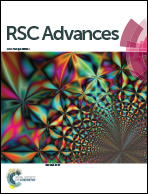Comparative study of aqueous solution processed ZnO/GaAs and ZnO/porous GaAs films
Abstract
In this paper, we investigate the structural and photoluminescence properties of aqueous solution-processed ZnO/GaAs and ZnO/porous GaAs films. According to X-ray diffraction (XRD) analysis, a ZnO film deposited on porous GaAs shows a monocrystalline structure with a-axis orientation, which is desirable for light emitting applications. The results obtained from atomic force microscopy (AFM) data confirm that a porous GaAs substrate is beneficial to deposit a uniform array of ZnO nanostructures with sizes down to 12 nm and a relatively low surface roughness (2.6 nm). Under excitation wavelength λexc = 375 nm, ZnO/GaAs and ZnO/porous GaAs films showed emissions in most of the visible spectral region (450–750 nm). Our study reveals that changing the wavelength of the excitation UV radiation makes it possible to control the photoluminescence (PL) properties of ZnO films. Enhancement of the PL intensity was noticed in the UV and visible spectral regions when ZnO is deposited on porous GaAs, which is promising for optoelectronic device applications.



 Please wait while we load your content...
Please wait while we load your content...